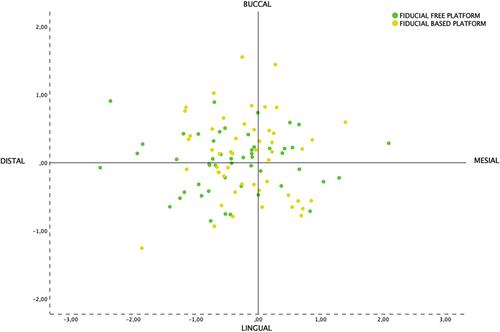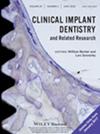Accuracy of navigation guided implant surgery for immediate loading complete arch restorations: Prospective clinical trial
Abstract
Objectives
To assess navigation accuracy for complete-arch implant placement with immediate loading of digitally prefabricated provisional.
Materials and Methods
Consecutive edentulous and terminal dentition patients requiring at least one complete-arch FDP were treated between December 2020 and January 2022. Accuracy was evaluated by superimposing pre-operative and post-operative cone beam computed tomography (CBCT), recording linear (mm) and angular (degrees) deviations. T-tests were performed to investigate the potential effect of the registration algorithm (fiducial-based vs. fiducial-free), type of references for the fiducial-free algorithm (teeth vs. bone screws), site characteristic (healed vs. post-extractive), implant angulation (axial vs. tilted), type of arch (maxilla vs. mandible) on the accuracy with p-value <0.05.
Results
Twenty-five patients, 36 complete-arches, and 161 implants were placed. The overall mean angular deviation was 2.19° (SD 1.26°). The global platform and apex mean deviations were 1.17 mm (SD 0.57 mm), and 1.30 mm (SD 0.62 mm). Meaningful global platform (p = 0.0009) and apical (p = 0.0109) deviations were experienced only between healed and post-extraction sites. None of the analyzed variables significantly influenced angular deviation. Minor single-axis deviations were reported for the type of jaw (y-axis at implant platform and apex), registration algorithm (y-axis platform and z-axis deviations), and type of references for the fiducial-free algorithm. No statistically significant differences were found in relation to implant angulation.
Conclusions
Within the study limitations navigation was reliable for complete-arch implant placement with immediate loading digitally pre-fabricated FDP. AI-driven surface anatomy identification and calibration protocol made fiducial-free registration as accurate as fiducial-based, teeth and bone screws equal as references. Implant site characteristics were the only statistically significant variable with healed sites reporting higher accuracy compared to post-extractive. Live-tracked navigation surgery enhanced operator performance and accuracy regardless of implant angulation and type of jaw. A mean safety room of about 1 mm and 2° should be considered.


 求助内容:
求助内容: 应助结果提醒方式:
应助结果提醒方式:


